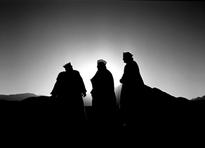ALBERT SERRA - (EL CANT DELS OCELLS)
ÉCRAN D'ART - SCREENING
The young Basque writer and director Albert Serra debuted in 2003 with ‘Crespia’. In a short period of time he built-up a firm reputation and is now compared with wilful filmmakers such as Pasolini, Warhol, Herzog, Costa and Rouch. His still very recent oeuvre betrays a great knack for epic stories in which grandiose landscapes contrast with very particular, human personas, mostly non-professional actors.
El cant dels ocells (Birdsong)
2008, 98’, B&W, Catalan & Hebrew spoken, French subtitles.
After having made ‘Honor de cavalleria’ (2006), a unique version of ‘El ingenioso hidalgo Don Quixote de la Mancha’, Cervantes’ famous novel, the filmmaker Albert Serra arched over to ‘El cant dels ocells’, about a still older, once again legendary tale: the biblical time around the birth of Christ, with, in particular, the trek of the three kings searching for the newborn child. According to Serra the only motive he had for making this film was to fulfil his personal wish for the three kings of the story – who he completely loves – to be immortal. Albert Serra worked with non-professional actors; the filmmaker insists on making a sharp contrast between the ‘natural’ character of his narrators and the strong fictional context in which he sets them. Also in ‘El cant dels ocells’ he creates hypothetical figures; his actors are personas of the possible, individuals in expectation of the story that they realise. The film works in two – apparently paradoxical – directions. On the one side this is, in terms of content, a totally fictional film, bordering on a fairytale. On the other side, the actors are of little more quality that the clothing that the role provides them. Albert Serra makes primitive cinema in sober black and white. In that sense, ‘El cant dels ocells’ also marks a return to the roots of cinematographic storytelling. This work also formally echoes early cinema.
The film has a transcendent effect, thanks to many close-ups of the three men, revealing their facial expressions, voices and gestures; equally, the beautifully brought images of gravelly, abandoned landscapes. Based on a freely written scenario of just thirty pages, the camera in ‘El cant dels ocells’ stays closely fixed on the actors. This to the point where emotions and absurdity melt together into a higher entity. It can, depending on the viewer’s interpretation, be experienced as religious or poetic – an entirely pure cinematographic experience.
El cant dels ocells (Birdsong)
2008, 98’, B&W, Catalan & Hebrew spoken, French subtitles.
After having made ‘Honor de cavalleria’ (2006), a unique version of ‘El ingenioso hidalgo Don Quixote de la Mancha’, Cervantes’ famous novel, the filmmaker Albert Serra arched over to ‘El cant dels ocells’, about a still older, once again legendary tale: the biblical time around the birth of Christ, with, in particular, the trek of the three kings searching for the newborn child. According to Serra the only motive he had for making this film was to fulfil his personal wish for the three kings of the story – who he completely loves – to be immortal. Albert Serra worked with non-professional actors; the filmmaker insists on making a sharp contrast between the ‘natural’ character of his narrators and the strong fictional context in which he sets them. Also in ‘El cant dels ocells’ he creates hypothetical figures; his actors are personas of the possible, individuals in expectation of the story that they realise. The film works in two – apparently paradoxical – directions. On the one side this is, in terms of content, a totally fictional film, bordering on a fairytale. On the other side, the actors are of little more quality that the clothing that the role provides them. Albert Serra makes primitive cinema in sober black and white. In that sense, ‘El cant dels ocells’ also marks a return to the roots of cinematographic storytelling. This work also formally echoes early cinema.
The film has a transcendent effect, thanks to many close-ups of the three men, revealing their facial expressions, voices and gestures; equally, the beautifully brought images of gravelly, abandoned landscapes. Based on a freely written scenario of just thirty pages, the camera in ‘El cant dels ocells’ stays closely fixed on the actors. This to the point where emotions and absurdity melt together into a higher entity. It can, depending on the viewer’s interpretation, be experienced as religious or poetic – an entirely pure cinematographic experience.

-
do 09.4.2009
21:30 - 23:00 -
Praktische info
Location:
Cinéma Arenberg
Koninginnegalerij 26 Galerie de la Reine
1000 Brussels
Entrance Fee:
8 / 6,6 Euro - Kunstenaars